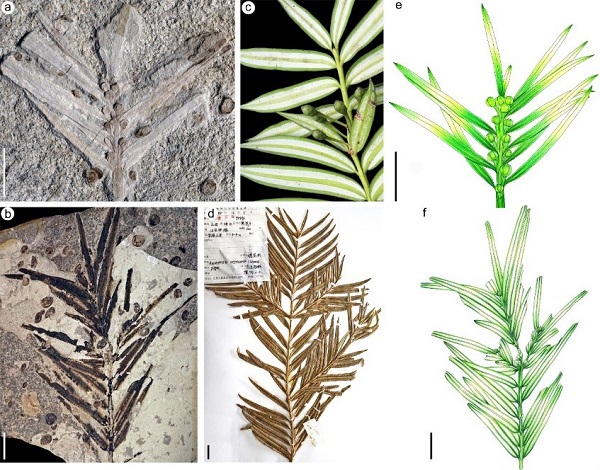Taxaceae, commonly known as yews, is widely cultivated all over the world and has been loved by most people. Taxaceae sensu stricto includes Taxus (yew), Pseudotaxus (whiteberry yew), Amentotaxus (catkin-yew), Austrotaxus (New Caledonia yew), and Torreya. Many species of yews are endangered in the wild. Extant Amentotaxus comprises five to six species, which all are the endangered species on the IUCN list.
The Taxaceae has a long history as the earliest group in the fossil record appeared in the earliest Jurassic, and probably had a certain diversity during the Jurassic and the Cretaceous. However, well-preserved fossil yews carrying important information have been extremely limited, especially absence of fossils preserved with reproductive organs, which result in the insufficient of our understanding of the origin and early evolution of the Taxaceae.
Recently, Dr. DONG Chong, Dr. SHI Gongle, and Professor WANG Yongdong of the Nanjing Institute of Geology and Palaeontology, Chinese Academy of Science (NIGPAS), and other members from the Chicago Botanic Garden, the Oak Spring Gardens Foundation and School of Forestry and Environmental Studies, Yale University, collaborated with a research focusing on the Middle?Late Jurassic yew fossils from the Daohugou Biota in northeastern China. Comparative morphological evidence and morphological phylogenic analysis both support that the fossils can be assigned to the genus Amentotaxus. The results show that, like Ginkgo, the catkin-yew is another living fossil dating back to the Middle?Late Jurassic that have undergone little morphological change over at least ~ 160 million years. This study was published online on June 2020 in the National Science Review, a high-level comprehensive academic journal.
The fossils were collected from the Daohugou Bed in the Daohugou village in Ningcheng County, Inner Mongolia. Well-preserved catkin-yew fossil shoots have linear-lanceolate leaves borne in opposite pairs that are decussately inserted, and opposite ultimate shoots that spread in more or less a single plane. Attached seed-bearing structures arise singly from the axil of a normal vegetative leaf and consist of a short, naked axis bearing a single terminal seed that is enclosed by up to five pairs of opposite and decussate bracts. These features closely resemble those of the extant catkin-yew Amentotauxs.
A close relationship of the Daohugou fossils to extant catkin-yews is consistent with the results of a phylogenetic analysis based on 13 groups scored for three Jurassic Taxaceae fossil species, and six extant species representing Cephalotaxus and the five genera Taxaceae. Both an unconstrained analysis and an analysis with the relationships of extant Taxaceae constrained to the topology of the molecular phylogeny support that it would be reasonable to assign to the Daohugou fossils to the catkin-yew Amentotauxs. The Middle?Late Jurassic Daohugou fossils confirm that the origin of the catkin-yew was at least 160 million years ago.
“Living fossil” firstly appeared in Darwin’s book on the Origin of Species in 1859. The morphological stasis reflected by the “Living fossil” is one of the most interesting scientific topics in evolutionary biology. China is rich in plant diversity, including a large number of ancient families or genera and relict groups. The credible fossil record of relictual genera such as Craigia, Davidia, Cyclocarya and Metasequoia extend back to the early Cenozoic, and Taiwania and Hedyosmum extend back into the Cretaceous. However, the extent of morphological stasis between Daohugou fossils and extant Amentotaxus highlights that, like Ginkgo, Amentotaxus is a living fossil and its earliest record extends back into the Jurassic.
This research was jointly supported by the National Science Foundation of China, the Strategic Priority Research Program (B) of the Chinese Academy of Sciences, the U. S. National Science Foundation, and Youth Innovation Promotion Association, CAS.
Article reference: Dong Chong, Shi Gongle*, Herrera F., Wang Yongdong, Herendeen P. S., Crane P. R., Middle-Late Jurassic fossils from northeastern China reveal morphological stasis in the catkin-yew. National Science Review. https://doi.org/10.1093/nsr/nwaa138

(a, b) cf. Amentotaxus from the Middle-Late Jurassic Daohugou Bed in eastern Inner Mongolia; (c, d) Extant Amentotaxus; (e, f) Reconstructive drawings of the cf. Amentotaxus from the Daohugou biota.
Download:
